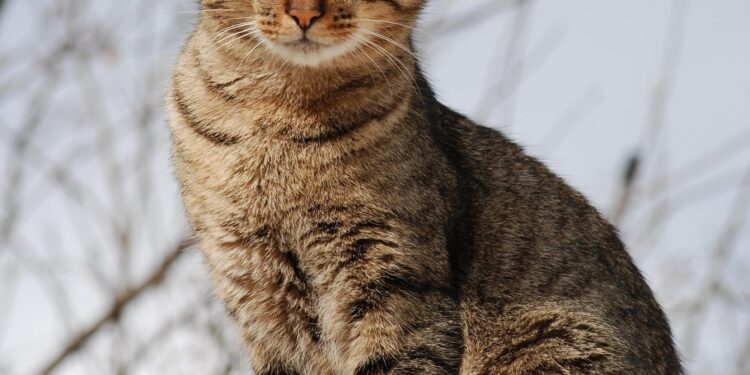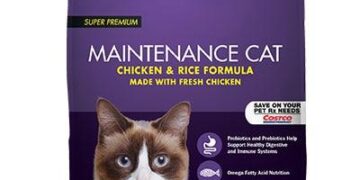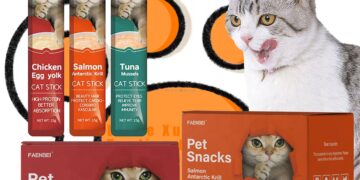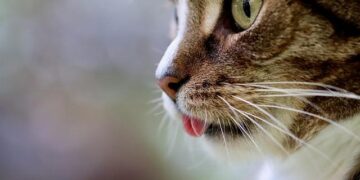Table of Contents
Introduction: Leo’s Story – A Journey from Chronic Illness to Radiant Health
The journey into the world of holistic feline nutrition often begins not with a scientific paper, but with a beloved P.T. For one owner, it began with Leo, a cat whose outward appearance belied a growing list of subtle but persistent health issues.
Despite being fed a “premium,” veterinarian-recommended brand of dry kibble, Leo was lethargic, his coat was dull and flaky, and he suffered from chronic digestive upset.1
This frustrating cycle of vet visits and inconclusive tests is a familiar story for many cat owners who watch their companions struggle with conditions that conventional wisdom fails to resolve.
These seemingly minor ailments are often the early warning signs of systemic, diet-related problems that plague the modern domestic cat.
A staggering 50% of cats in the United States are considered obese, a condition that dramatically increases their risk for arthritis, diabetes, and even cancer.2
Issues like pancreatitis, heart disease, and Feline Lower Urinary Tract Disease (FLUTD) are also distressingly common and have direct links to nutrition.2
For Leo’s owner, the turning point was the realization that the promise of “complete and balanced” nutrition printed on the food bag was not translating to a healthy, thriving animal.
This marked the beginning of a deep investigation into what a cat is biologically designed to eat, a journey that transformed a passive consumer into an empowered health advocate.
This guide chronicles that journey, offering a clear path from the confusion of the pet food aisle to the confidence of providing a truly nourishing, species-appropriate diet.
Chapter 1: The Ancestral Blueprint: Deconstructing the Diet of an Obligate Carnivore
To understand what to feed a cat, one must first understand what a cat is.
Felines are not small dogs; they are obligate carnivores, a biological classification that defines their nutritional needs with exacting precision.5
For millennia, their ancestors thrived on a diet of small prey—rodents, birds, and insects—a nutritional blueprint that modern cat food has, in many cases, abandoned.7
The Macronutrient Imperative: High Protein, Moderate Fat, Low Carb
The body of a cat is a finely tuned engine designed to run on animal-based nutrients.
- Animal Protein: As obligate carnivores, cats utilize protein as their primary source of energy. It is essential for muscle development, organ maintenance, and overall health.9 Critically, this protein must come from animal sources, as they contain a complete amino acid profile. This includes nutrients like taurine and arginine, which cats cannot synthesize in sufficient quantities on their own.6 A deficiency in taurine, for example, can lead to devastating health consequences, including severe heart disease and blindness.4
- Animal Fat: A moderate amount of fat from animal sources provides a concentrated, slow-release form of energy and delivers essential fatty acids that are vital for skin and coat health.12
- Carbohydrates: Herein lies the greatest disconnect between a cat’s needs and conventional pet food. A cat’s natural diet of prey contains only about 2-3% carbohydrates.12 Yet, the average bag of dry kibble contains between 30% and 50% carbohydrates, primarily from inexpensive fillers like corn, wheat, soy, and peas.11 Feline physiology is simply not equipped to handle this carbohydrate load; cats lack the specific digestive enzymes required to break them down efficiently.14
A fundamental problem in the pet food industry is the gap between what is considered “nutritionally complete” and what is biologically appropriate.
A food can be legally labeled “complete and balanced” by the Association of American Feed Control Officials (AAFCO) if it meets a checklist of minimum nutrient requirements.15
However, these minimums can be met using synthetic vitamin and mineral packs added to a base of highly processed, carbohydrate-heavy ingredients.
A food can technically be “complete” while being 50% corn, a formula that is fundamentally at odds with the needs of a carnivorous animal.13
Therefore, the goal for a discerning owner is to find a food that is not only complete according to regulatory standards but is, more importantly, appropriate for the species it is intended to nourish.
This leads to another common pitfall: the illusion of high protein from plant-based sources.
To meet the protein percentages required by AAFCO, many manufacturers use inexpensive plant-protein concentrates like corn gluten meal or pea protein.11
While this boosts the “Crude Protein” number on the guaranteed analysis, it is a misleading metric.
These plant proteins are not as bioavailable to a cat and, crucially, they lack the full spectrum of essential amino acids, like taurine, that can only be found in animal tissue.9
This highlights the critical importance of evaluating not just the
quantity of protein in a cat’s food, but its source.
The Unseen Nutrient: The Critical Role of Moisture
Perhaps the most overlooked and vital component of a cat’s ancestral diet is water.
Having evolved in arid, desert environments, cats developed a naturally low thirst drive.3
They are biologically designed to obtain the vast majority of their hydration directly from the moisture-rich bodies of their prey.11
A mouse or a small bird is composed of approximately 70-75% water—a figure that is almost perfectly mirrored in high-quality canned or raw cat food.11
In stark contrast, dry kibble contains a mere 10-12% moisture.11
This dramatic disparity forces a kibble-fed cat’s body to function in a state of chronic, low-grade dehydration.
This puts an immense and constant strain on the kidneys and urinary system, and it is a primary contributing factor to the epidemic of Feline Lower Urinary Tract Disease (FLUTD) and chronic kidney disease seen in domestic cats today.2
No amount of water a cat drinks from a bowl can fully compensate for the lack of moisture in its food.
Chapter 2: The Trouble with Kibble: How Modern Processing Diminishes Nutrition
The convenience of dry kibble is undeniable, but that convenience comes at a steep nutritional cost.
The journey from whole ingredients to the finished pellet involves an aggressive manufacturing process called extrusion, which fundamentally alters the food’s composition and diminishes its value.
Deconstructing Extrusion and Nutrient Degradation
Extrusion involves mixing ingredients into a dough, which is then subjected to extremely high temperatures and pressure before being forced through a die and cut into pellets.18
This harsh process is highly destructive to the delicate nutrients naturally present in the food.
- Vitamin Loss: Sensitive vitamins, including the B-group vitamins, vitamin A, and vitamin E, are significantly degraded by the intense heat of extrusion.18
- Protein Damage: The high temperatures also denature proteins, changing their structure and making them more difficult for a cat’s digestive system to break down and absorb.20 Even more concerning is a chemical process known as the
Maillard reaction. This reaction between amino acids and sugars, prompted by heat, effectively binds the essential amino acid lysine, rendering it biologically unavailable to the cat.21 Scientific analyses have revealed that the difference between total lysine and available (reactive) lysine in commercially produced pet foods can be substantial, with reductions of up to 48.7% in dry cat foods and a staggering 61.8% in some canned foods.21
This destructive cycle of processing necessitates a compensatory step: fortification.
To meet AAFCO’s “complete and balanced” standards, manufacturers must add a synthetic premix of vitamins and minerals back into the food after the natural nutrients have been destroyed.16
This creates a nutritional paradox.
The very process used to create the food strips it of its inherent value, which is then replaced by a synthetic, and potentially less effective, substitute.
This helps explain why a cat like Leo, eating a “premium” and “complete” diet, could still exhibit signs of nutritional deficiency.
The nutrients were listed on the bag, but they may not have been in a form his body could readily use.
Furthermore, the act of ultra-processing may not be nutritionally neutral; it can introduce potentially harmful compounds.
The same Maillard reaction that damages lysine also creates substances known as advanced glycation end-products (AGEs).21
While research in companion animals is still developing, in human nutrition, a high dietary intake of AGEs is linked to oxidative stress, inflammation, and the progression of chronic diseases.18
This reframes the conversation from simply “fresh food is better” to the more urgent possibility that “highly processed food could be actively detrimental.”
The Bioavailability Gap: Whole Food vs. Synthetic Nutrients
The core of the issue lies in the concept of bioavailability—it’s not what a cat ingests, but what its body can actually absorb and utilize.7
Imagine the difference between eating a whole orange and taking a vitamin C tablet.
The orange contains not just ascorbic acid, but also fiber, flavonoids, and a complex matrix of other phytonutrients that work synergistically to enhance the body’s ability to absorb and use the vitamin.22
Similarly, the vitamins, minerals, and amino acids found in their natural state within whole meats, organs, and bone are typically more bioavailable to a carnivore’s digestive system than the isolated, synthetic nutrients manufactured in a lab and added back to processed food.22
While canned food is a significant step up from kibble due to its high moisture content, it is not immune to the effects of processing.
The high-heat sterilization required for canning also degrades vitamins and can negatively impact protein quality, though generally to a lesser extent than extrusion.18
Chapter 3: The Holistic Philosophy: Nourishing the Whole Cat
Navigating the pet food aisle requires a new vocabulary and a new way of thinking.
It means looking past the marketing slogans and understanding the philosophy behind the food.
Defining Our Terms: “Holistic” vs. “Natural”
It is crucial to understand the language used on pet food packaging, as it can be misleading.
- Holistic: This term is completely unregulated in the pet food industry. Any manufacturer can print “holistic” on their packaging without meeting any specific requirements.15 At its best, the term suggests a philosophy of promoting whole-body health by considering how all components of a diet work together.10 At its worst, it is an empty marketing buzzword.
- Natural: This term, in contrast, has a specific definition set by AAFCO. It means that a feed or ingredient is “derived solely from plant, animal, or mined sources… not having been produced by or subject to a chemically synthetic process”.15 Most high-quality foods will carry the label “Natural with added vitamins, minerals, and trace nutrients,” acknowledging the need for some supplementation to create a complete diet.
The most effective approach is to adopt the philosophy of holistic care—nourishing the whole cat—by seeking out foods that adhere to the verifiable principles of a natural, species-appropriate diet, rather than simply trusting a single word on the bag.
The Pillars of a Truly Holistic Diet
A genuinely superior cat food is built on four key pillars:
- Species-Appropriate Ingredients: The foundation of the food is high-quality, animal-based protein from named sources (e.g., chicken, turkey, beef).10 It avoids plant-protein concentrates and keeps carbohydrate content to a biological minimum.
- Whole-Food Nutrition: The recipe emphasizes whole meats, organs, and bone rather than processed by-products or anonymous “meat meals”.23 It recognizes that the nutritional synergy of whole foods is superior to a diet built from fractionated ingredients and synthetic supplements.7
- Minimal Processing: The food is prepared using methods that preserve the integrity of the ingredients. This means preferring gentle processes like freeze-drying or raw preparation over the high-heat, high-pressure violence of extrusion.10
- Absence of Harmful Additives: The ingredient list is clean and free from artificial preservatives like BHA, BHT, and ethoxyquin (which have been linked to organ disease and cancer), artificial colors and flavors, and controversial thickening agents like carrageenan.7
This philosophy can be undermined by the “whole food” paradox in pet food marketing.
As human consumers have embraced whole foods, pet food manufacturers have followed suit, sometimes with misleading results.
A bag of kibble might prominently feature images of carrots, sweet potatoes, and blueberries to appeal to the owner’s sense of what is healthy.7
However, this is a nutritional trap.
Cats, as carnivores, cannot convert the beta-carotene in carrots and sweet potatoes into usable Vitamin A; they require preformed Vitamin A, which is only available from animal sources like liver.7
These plant ingredients, while sounding wholesome, are often little more than carbohydrate fillers that are biologically inappropriate for a cat.
A truly holistic approach for a feline must be relentlessly carnivore-centric.
How to Read a Pet Food Label Like an Expert
- The Ingredient List: The first five ingredients comprise the majority of the food’s weight. These should be high-quality, named animal proteins.11 Be wary of “ingredient splitting,” a tactic where a manufacturer lists multiple forms of a single cheap ingredient (e.g., peas, pea protein, pea fiber) to push them down the list and make the meat content appear higher than it is.23
- The Guaranteed Analysis (GA): The percentages listed for protein, fat, and fiber are on an “as-fed” basis. This makes it impossible to directly compare a high-moisture wet food to a low-moisture dry food. To make an accurate comparison, one must convert these numbers to a Dry Matter Basis (DMB). This is done by dividing the reported percentage of a nutrient by the total percentage of dry matter in the food (100% minus the moisture percentage).
- The AAFCO Statement: This small print is vital. It will state whether the food is “formulated to meet the nutritional levels established by the AAFCO Cat Food Nutrient Profiles” or if “animal feeding trials substantiate that [the food] provides complete and balanced nutrition.” The latter represents a higher standard of validation, as it means the food was actually fed to cats to ensure it performs as expected.
Chapter 4: A Guide to the Modern Marketplace: Navigating the Spectrum of Holistic Foods
Armed with an understanding of feline biology and the pitfalls of processing, the modern cat owner can confidently navigate the marketplace.
The best food is not a single product but falls along a spectrum of quality.
The ideal choice is the highest-quality food that is sustainable for an owner’s budget and lifestyle.
The Hierarchy of Quality
- Good: High-Quality Canned/Wet Food: The essential high moisture content makes premium canned food vastly superior to any dry kibble.
- Better: Dehydrated or Freeze-Dried Raw Food: These foods offer the nutritional benefits of raw ingredients with the convenience of a shelf-stable product.
- Best: Commercially Prepared, Balanced Raw Food: This represents the gold standard, offering unparalleled nutrient bioavailability in a form that most closely mimics a cat’s ancestral diet.
The following table provides a comparison of leading brands across this spectrum, using Dry Matter Basis (DMB) for accurate macronutrient analysis.
| Key Table: Holistic Cat Food Brand Comparison (Dry Matter Basis) |
| Brand |
| Tiki Cat |
| Hound & Gatos |
| Stella & Chewy’s |
| Darwin’s Pet |
| Vital Essentials |
Detailed Brand Breakdowns
Premium Canned (The Gateway to Holistic)
- Tiki Cat: This brand is renowned for its focus on shredded, recognizable whole meat in a moisture-rich broth or consommé.41 The
After Dark line is particularly species-appropriate, as it includes nutrient-dense organ meats like heart, liver, and gizzard.27 With some of the lowest carbohydrate content on the market, Tiki Cat is an excellent choice for diabetic or overweight cats.29 However, some of their formulas can be lower in fat than a true prey-model diet.29 - Hound & Gatos: This company adheres to a strict “paleolithic” dietary philosophy, with simple formulas that are 98% single-source animal protein.42 Their ingredient lists are exceptionally clean, avoiding all fillers, and they use agar-agar as a binder instead of the more controversial carrageenan.31 This makes them a top-tier option for cats with food allergies or Inflammatory Bowel Disease (IBD).
Freeze-Dried Raw (Convenience Meets Quality)
- Stella & Chewy’s: A leader in the freeze-dried category, this brand offers a convenient entry point into raw feeding.35 The freeze-drying process gently removes water while preserving the nutritional integrity of the raw ingredients without the use of high heat.45 Critically, they employ High-Pressure Processing (HPP), a cold-pasteurization technique that neutralizes harmful pathogens, addressing a primary concern with raw food.46 Their formulas are 98% meat, organs, and bone, but the high bone content can lead to elevated phosphorus levels, which may be unsuitable for cats with compromised kidney function.33
- Vital Essentials: This brand operates on a “whole animal” or “butcher cut” philosophy, utilizing meat, organs, and bone to create a diet that closely mimics a whole-prey animal.40 They are notable for their stringent USA-based sourcing and manufacturing standards, holding a Global Food Safety Initiative (GFSI) certification, one of the highest safety benchmarks in the industry.38
Frozen Raw (The Gold Standard)
- Darwin’s Natural Pet Food: Often considered the pinnacle for dedicated owners, Darwin’s is a subscription service that delivers frozen, pre-portioned raw meals. Their recipes are formulated by veterinary nutritionists to meet AAFCO standards for all life stages, ensuring nutritional completeness.36 The company is transparent with its nutritional data, providing detailed breakdowns of mineral and amino acid profiles.36 Owners who feed Darwin’s frequently report dramatic improvements in their cats’ health, including better digestion, higher energy levels, and smaller, nearly odorless stools—a hallmark of a highly digestible, species-appropriate diet.37
The Raw Food Controversy: A Balanced Perspective
No discussion of holistic pet food is complete without addressing the controversy surrounding raw diets.
Major veterinary organizations, including the American Veterinary Medical Association (AVMA), officially discourage the feeding of raw animal protein due to the risk of contamination with pathogenic bacteria like Salmonella and Listeria, which can sicken both pets and the humans handling the food.48
Other documented risks include the potential for nutritional imbalances in poorly formulated homemade diets and the danger of bone fragments causing internal injury.49
These are valid concerns that must be taken seriously.
However, it is equally important to recognize that the risks can be significantly mitigated.
Reputable commercial raw food manufacturers like Stella & Chewy’s and Darwin’s invest heavily in safety protocols.
They source ingredients from trusted suppliers, operate under strict sanitation controls, and utilize pathogen-reduction steps like HPP.46
They also test their finished products to ensure they are free from contaminants.
By choosing a high-quality commercial raw product and practicing diligent food safety at home—such as washing hands and surfaces thoroughly—owners can safely provide the unparalleled nutritional benefits of a raw diet.52
Chapter 5: Making the Change: A Practical Guide to a Successful Transition
Switching a cat from a highly processed, carbohydrate-addictive kibble to a nutrient-dense, species-appropriate diet requires patience.
A slow and steady approach is essential for success.
The Gradual Method
An abrupt diet change can cause digestive upset.
The best method is a gradual transition over a period of 7 to 14 days.
Start by mixing a small amount of the new food (about 10-25%) with the old food.
Every few days, slowly increase the proportion of the new food while decreasing the old, until the transition is complete.
What to Expect: The Good and The Temporary
The positive changes that followed Leo’s dietary transition are typical for many cats.
Within weeks, owners often observe a softer, shinier coat, a noticeable increase in energy and playfulness, and a dramatic improvement in digestion, evidenced by smaller, firmer, and significantly less odorous stools.11
However, the transition period can sometimes involve temporary setbacks.
A cat’s digestive system, long accustomed to a diet high in carbohydrates, may need time to adapt to a richer, higher-protein food.
This can manifest as temporary loose stools.
Supplementing with a high-quality probiotic during the transition can help support a healthy gut microbiome and ease this adjustment period.7
Tips for Picky Eaters
Cats are notoriously neophobic, or resistant to new things, especially food.
Kibble is often coated with artificial “animal digest” sprays to make it highly palatable, and a cat may need to be weaned off this addictive flavoring.
Strategies for enticing a picky eater include:
- Warming the food slightly to enhance its aroma.
- Adding a tempting topper, such as a sprinkle of crushed freeze-dried treats or a spoonful of high-quality bone broth.53
- Experimenting with textures. Some cats prefer a smooth pâté, while others enjoy shredded or minced textures.
Throughout the transition and beyond, ensuring adequate hydration is paramount.
Always provide access to fresh, clean water.
Because cats are often poor drinkers, using a water fountain can entice them to drink more, further supporting their urinary and kidney health.11
Conclusion: Becoming Your Cat’s Health Advocate
Leo’s story has a happy ending.
The listless cat with the dull coat and troubled digestion transformed into a vibrant, energetic companion with a gleaming coat and perfect health.
This was not a miracle; it was the logical and predictable outcome of aligning his diet with his fundamental biological needs.
His recovery underscores a powerful truth: nutrition is the foundation of health.
This guide is not intended as a rigid prescription, but as a framework for understanding and a compass for navigating the complex landscape of feline nutrition.
The journey from a conventional, processed diet to a holistic, species-appropriate one is one of the most profound acts of love and advocacy an owner can undertake for their cat.
By looking beyond the marketing and focusing on the biological facts, every cat owner can become their pet’s most powerful and informed champion, ensuring a long, vibrant, and healthy life.
Works cited
- 4 Reasons To Consider Holistic Cat Food – VēRUS Pet Foods, accessed August 16, 2025, https://www.veruspetfoods.com/updates/4-reasons-to-consider-holistic-cat-food/
- 5 Common Cat Illnesses that are Impacted by Nutrition | PetMD, accessed August 16, 2025, https://www.petmd.com/cat/centers/nutrition/cat-diarrhea-and-other-diseases-impacted-by-nutrition
- 5 Common Cat Health Issues and How Nutrition Can Help – Birdie & Louie, accessed August 16, 2025, https://birdieandlouie.com/blogs/news/5-common-cat-health-issues-and-how-nutrition-can-help
- Diet-Related Disorders – Catwatch Newsletter, accessed August 16, 2025, https://www.catwatchnewsletter.com/features/diet-related-disorders/
- Species Appropriate Nutrition – The Wylie Veterinary Centre, accessed August 16, 2025, https://www.wylievets.com/news/species-appropriate-nutrition
- The best diet for your cat – PDSA, accessed August 16, 2025, https://www.pdsa.org.uk/pet-help-and-advice/looking-after-your-pet/kittens-cats/the-best-diet-for-your-cat
- Best Holistic Cat Food: Our Top 5 Picks – Cats.com, accessed August 16, 2025, https://cats.com/reviews/natural-holistic-cat-food
- Dry foods and risk of disease in cats – PMC, accessed August 16, 2025, https://pmc.ncbi.nlm.nih.gov/articles/PMC2387258/
- Get advice for your cat—natural diet vs. commercial food?, accessed August 16, 2025, https://untamed.com/blogs/nutrition/cat-natural-diet
- A Point of View on Cat Nutrition – from Holistic Veterinarians – Know …, accessed August 16, 2025, https://www.knowbetterpetfood.com/blogs/blog/a-point-of-view-on-cat-nutrition-from-holistic-veterinarians
- Feline Nutrition | Stray Haven – Stray Haven Rescue, accessed August 16, 2025, http://strayhavenrescue.org/feline-nutrition/
- Fresh Cat Food: Homemade VS Dry Commercial – Dr. Ruth Roberts, accessed August 16, 2025, https://drruthroberts.com/blogs/pet-blog/fresh-food-for-your-cat-homemade-vs-dry-commercial
- Is processed cat food good for cats? – Quora, accessed August 16, 2025, https://www.quora.com/Is-processed-cat-food-good-for-cats
- homescapepets.com, accessed August 16, 2025, https://homescapepets.com/blogs/articles/species-appropriate-food-101-what-it-means-where-to-start#:~:text=When%20looking%20for%20species%20appropriate,break%20down%20and%20digest%20carbs.
- What’s in Natural Cat Food and Holistic Cat Food? – PetMD, accessed August 16, 2025, https://www.petmd.com/cat/nutrition/whats-natural-cat-food-and-holistic-cat-food
- Is Organic Cat Food Better for My Cat? – Purina, accessed August 16, 2025, https://www.purina.com/articles/cat/health/nutrition/is-organic-cat-food-better
- Choosing Species Appropriate Diet | Southlake Animal Hospital P.C., accessed August 16, 2025, https://merrillvillevets.com/choosing-species-appropriate-diet/
- The Impact of Processing on the Nutrient Content of Commercial Pet …, accessed August 16, 2025, https://www.bigdogpetfoods.com/guides/the-impact-of-processing-on-the-nutrient-content-of-commercial-pet-foods
- Ingredient and Product Processing in Pet Food: Balancing Nutrition, Temperature, Safety, and Quality, accessed August 16, 2025, https://www.foodresearchlab.com/animal-food-product-development/ingredient-and-product-processing-in-pet-food/
- Choosing a Quality Pet Food – Earth Animal, accessed August 16, 2025, https://earthanimal.com/blog/2022/03/22/choosing-a-quality-pet-food/
- The Maillard reaction and pet food processing: effects on nutritive value and pet health | Nutrition Research Reviews – Cambridge University Press, accessed August 16, 2025, https://www.cambridge.org/core/journals/nutrition-research-reviews/article/maillard-reaction-and-pet-food-processing-effects-on-nutritive-value-and-pet-health/E085D3648D6A209003AB4D0DB72DB8B2
- Bioavailability and Nutrition – Guides – Big Dog Pet Foods, accessed August 16, 2025, https://www.bigdogpetfoods.com/guides/bioavailability-and-nutrition
- Holistic Healthy Weight Support Grain Free Chicken Recipe Indoor Dry Cat Food – Halo Pets, accessed August 16, 2025, https://halopets.com/products/holistic-chicken-grain-free-indoor-cat-food-healthy-weight
- Natural and Holistic Cat Food: What’s the Difference? – CanTastic for Pets, accessed August 16, 2025, https://cantasticforpets.com/blogs/news/natural-and-holistic-cat-food-whats-the-difference
- www.veruspetfoods.com, accessed August 16, 2025, https://www.veruspetfoods.com/updates/4-reasons-to-consider-holistic-cat-food/#:~:text=Holistic%20cat%20food%20emphasizes%20the,as%20fillers%20and%20by%2Dproducts.
- Healthy Dog & Cat Food with our Unique Digestive Health Support System | Holistic Select®, accessed August 16, 2025, https://www.holisticselect.com/
- Tiki Cat® After Dark™ Chicken & Beef, accessed August 16, 2025, https://tikipets.com/product/tiki-cat/tiki-cat-wet-food/shredded-cat/after-dark/chicken-beef/
- Unbiased Tiki Cat Cat Food Review – Cats.com, accessed August 16, 2025, https://cats.com/tiki-cat-cat-food-review
- Natural Pet Food Ingredients | Premium Nutrition – Hound & Gatos, accessed August 16, 2025, https://houndgatos.com/sample-page/about/our-ingredients/
- Unbiased Stella & Chewy’s Cat Food Review – Cats.com, accessed August 16, 2025, https://cats.com/stella-chewys-cat-food-review
- The 7 Best Frozen and Freeze-Dried Raw Cat Food – The Spruce Pets, accessed August 16, 2025, https://www.thesprucepets.com/best-frozen-and-freeze-dried-raw-cat-food-4153804
- Raw Chicken Cat Food: Natural Selections | Darwin’s, accessed August 16, 2025, https://www.darwinspet.com/products/natural-selections-for-cats-chicken
- Benefits of Raw Dog & Cat Food | Darwin’s Natural Pet Products, accessed August 16, 2025, https://www.darwinspet.com/blogs/why-raw/benefits-of-raw-dog-cat-food
- High-Quality Food for Dogs | Vital Essentials Raw Pet Food, accessed August 16, 2025, https://www.vitalessentials.com/
- What ingredients are in Vital Essentials Raw Diet Pet Food?, accessed August 16, 2025, https://www.vitalessentials.com/raw-guide/what-ingredients-are-in-vital-essentials-raw-diet-pet-food
- Tiki Cat Wet Food: Whole Foods, Mousse and Pate, accessed August 16, 2025, https://tikipets.com/product-category/tiki-cat/tiki-cat-wet-food/
- Wet Cat Food – Hound and Gatos, accessed August 16, 2025, https://houndgatos.com/product-categories/wet-cat-food/
- Hound & Gatos: Home, accessed August 16, 2025, https://www.houndgatos.com/
- Top Freeze-Dried Food Brands for Cats: Why Your Feline Deserves the Best, accessed August 16, 2025, https://www.thehungrypuppy.com/blogs/posts-from-the-pup/top-freeze-dried-food-brands-for-cats-why-your-feline-deserves-the-best
- Stella & Chewy’s Grain-Free Freeze Dried Cat Food – Only Natural Pet, accessed August 16, 2025, https://www.onlynaturalpet.com/products/stella-chewys-grain-free-freeze-dried-cat-food
- Complete and Balanced Dog & Cat Food | Stella & Chewy’s, accessed August 16, 2025, https://www.stellaandchewys.com/blogs/articles/complete-balanced
- Unbiased Darwin’s Natural Cat Food Review – Cats.com, accessed August 16, 2025, https://cats.com/darwins-natural-cat-food-review
- Raw diets for dogs and cats | American Veterinary Medical Association, accessed August 16, 2025, https://www.avma.org/resources-tools/avma-policies/raw-or-undercooked-animal-source-protein-cat-and-dog-diets
- Raw Food Diets in Cats – VCA Animal Hospitals, accessed August 16, 2025, https://vcahospitals.com/know-your-pet/avoiding-raw-food-in-cats
- Raw diets for dogs and cats: a review, with particular reference to microbiological hazards, accessed August 16, 2025, https://pmc.ncbi.nlm.nih.gov/articles/PMC6849757/
- FOOD FOR THOUGHT: Raw Diets – Cats Only Veterinary Hospital, accessed August 16, 2025, https://catsonlyvethosp.com/blog/2019/08/20/food-for-thought-raw-diets/
- Get the Facts! Raw Pet Food Diets can be Dangerous to You and Your Pet – FDA, accessed August 16, 2025, https://www.fda.gov/animal-veterinary/animal-health-literacy/get-facts-raw-pet-food-diets-can-be-dangerous-you-and-your-pet
- Natural & Organic Wet Cat Food, accessed August 16, 2025, https://www.onlynaturalpet.com/collections/wet-cat-food






